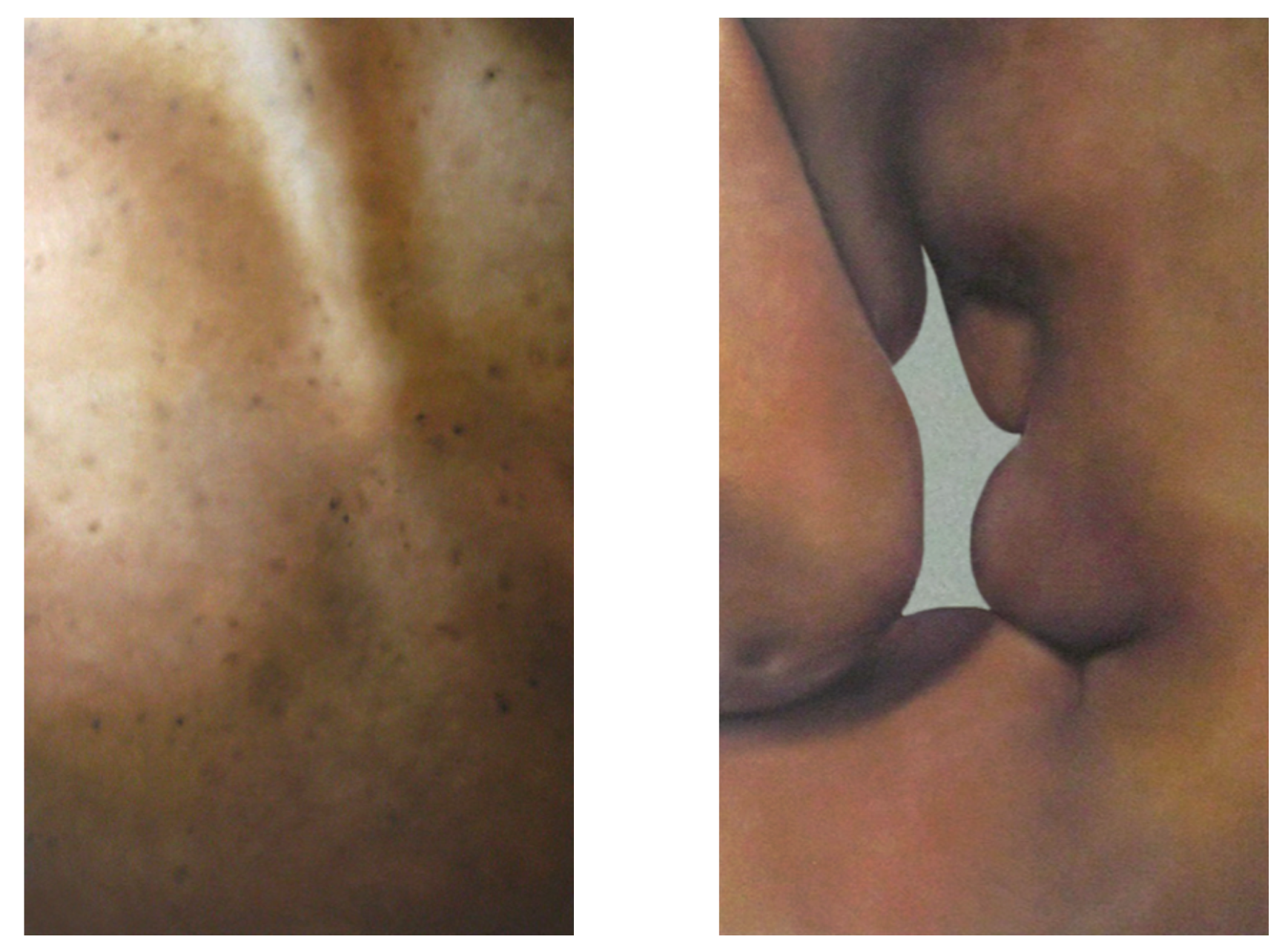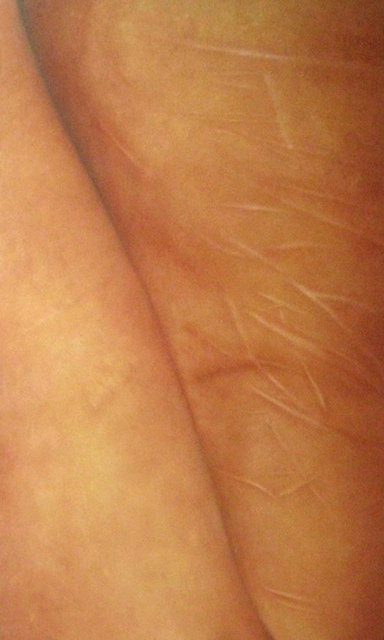Portfolio: Amel Janae
Strength, 2021, oil on glass, 5 x 3 ft. All photos by Kaidan Pascua.
[Image description: A closeup of two body parts folded together. The skin on the figure’s left side is light and changes to a medium-dark color on the right.]
Studio visits with artists I admire are perhaps the greatest pleasure of my practice as a curator and writer. I’ve followed San Diego-based artist Amel Janae closely for years and, last summer, visited her studio to see a new series in process. I had seen shots of the paintings on Instagram; familiar with Janae’s dazzling technical facility, I was eager to view them in person. She was working on My Skin, My Logo (2021), a suite of figurative paintings on mirror. As suggested by the title, the figures’ skin jumps out immediately; the way Janae uses paint to render the epidermis’s nuance in color and texture is striking. Like much of her past work, these images are distinctively, tightly cropped to depict only parts of the body, never the form in its entirety. In some of the paintings, Janae leaves the image’s negative space bare, the mirror exposed, reflecting the room around and the viewer standing in front of it. This balance of three-dimensional space, a limited view of the body, and aesthetic realism creates a compelling sense of both intimacy and anonymity.
Left: Relief, 2021, oil on glass, 5 x 3 ft.; Enough, 2021, oil on glass, 5 x 3 ft.
[Image descriptions: Left: A closeup of a figure’s waist— horizontally oriented as if they are laying on their side— occupies most of the image. The figure has light skin and folds of fat at the waist. A portion at the top of the image is left blank with a gray background. Right: An expanse of skin occupies most of the image, its edge curving upward to the left and leaving a glimpse of gray background in the upper right of the image. The skin is light with brown spots and a larger dark portion on the lower right.]
While walking me through the studio, Janae showed me images on her laptop— references for the series that she’s pulled from social media. Janae has always selected images of people with an expansive range of skin tones to serve as the basis for her paintings, and she now mentions that for this series she is including people with skin conditions. Indeed, the images in front of me evidence Janae reaching beyond race and ethnicity to depict skin bearing specific characteristics that are often considered flaws. She tenderly depicts dots of hyperpigmentation and vitiligo’s stark white blossoms on dark skin, as well as hatch-marked scars and soft folds of fat. I am struck by this expansion of subject, and the significance of the vehicle by which it arrived in Janae’s work: Instagram.
I spend a lot of time on Instagram. I live with a chronic illness that comes in waves and there are periods when I don’t feel good enough to do much else besides scroll. It provides a distraction from physical sensation, but has also become a portal into a community that sustains me intellectually and emotionally. Janae’s work reminds me of how, on a phone’s small screen, people with chronic illness use Instagram to both document and shape their experiences, and to connect with one another. If you spend enough time on the platform, door after door opens into overlapping communities— chronic illness links to a wide range of disability, disability to fatness, Queerness, and the experience of living in a skin that’s not white or “flawless.” Many in these communities bear multiple experiences at once, their intersectionality fully visible, and much of their Instagram content has to do with representing their own bodies.
Left: Linger, 2021, oil on glass, 5 x 3 ft.; Burden, 2021, oil on glass, 5 x 3 ft.
[Image descriptions: Left: A closeup of a person’s upper back. Their skin is light with brown spots. The lower portion of the figure is in shadow. Right: A closeup of a medium-dark skinned figure’s torso bent forward. Negative space at the image’s center is framed by their undulating stomach, upper leg, and elbow resting on their leg.]
Looking at Janae’s work, I think of the ways in which social media demonstrates a capacity to simultaneously make some things immeasurably better while making other things overwhelmingly worse. The space created by these platforms has done much for representation, via self-representation; people who have long been excluded from public view take control of the production of their own images, putting them out into the online world in a manner informed by lived experience. Through photographs and text, people of color, fat people, Queer people, and disabled people can reframe conversations around their own bodies and attendant ideas about worth. Yet of course platforms such as Instagram serve as a deeply imperfect, at times harmful, tool. Efforts to diversify bodily representation through social media are regularly twisted by capitalist, white supremacist, anti-fat, and ableist forces. For example, the rhetoric of the body positivity movement, pioneered by fat activists, has been widely co-opted by thin women into a public self-esteem boost, so much as to make it all but useless to those seeking fat liberation. People with physical differences, such as some of the skin conditions Janae depicts, are subject to relentless cruelty online. The term “self care,” coined by Audre Lorde in 1988 to describe a survival mechanism for Black women, is now deployed to fuel a multi-billon dollar industry of face masks and dangerous juice cleanses, advertised so effectively on Instagram. But again, many people still find connection, a sense of belonging, and vital critical tools in this digital space that regularly serves as a vehicle for harm. Frustratingly— dizzyingly, even— social media’s good and its bad continuously meet in a contradictory tangle.
Worth, 2021, oil on glass, 5 x 3 ft.
[Image description: A closeup of two body parts folded together. The figure’s skin is a light-medium color and numerous short, light lines are visible on the right side.]
Although it’s easy to lose sight of these points while endlessly scrolling, I don’t think much of what I’ve said here about social media is particularly insightful— but Janae’s straightforward material gesture, painting on mirror, is. Standing in front of the work from My Skin, My Logo in person, it’s startling for viewers to see themselves reflected in the mirror. Our own images are given back to us, not alone, but as a composite with the bodies Janae paints. This encounter invokes an elementary reality that many seem to readily and continuously forget; not only do we share space with others’ bodies in a physical sense, but we are implicated in a shared existence. Ultimately, we cannot extricate ourselves from the bodies around us. We are all active participants, responsible for the ways in which we view the bodies around us and how those views impact our actions toward each other, even when we are separated by a screen. Janae’s paintings, I believe, act as a call for care in how we navigate the intimately interpersonal existence of bodies in space— whether digital or IRL— and the people who inhabit them. It is a simple but desperately needed reminder.
—Elizabeth Rooklidge, independent curator and Editor of HereIn




